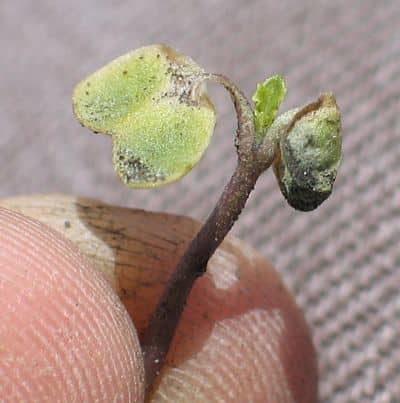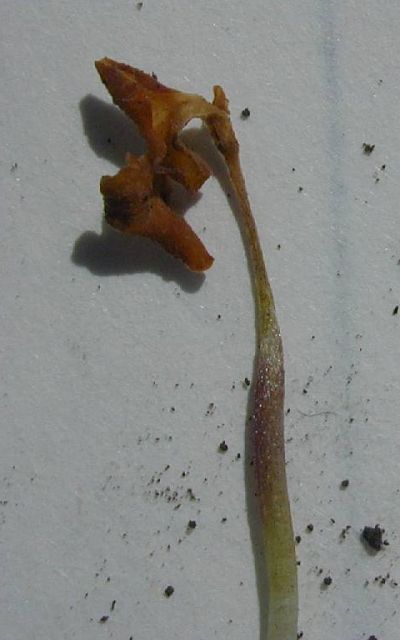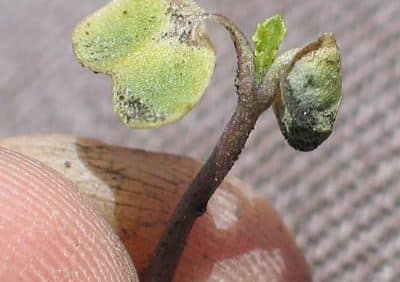Many areas across the Prairies had frost in the past week. Some had fairly heavy frost, with -6 C reported in some locations. Other areas had just a light frost of -1 C or so. Two key questions arise after a frost: Did the crop survive? When can I resume weed control?
How to answer the questions:

Did the crop survive?
You can get a good sense of frost severity the day of the frost, but it takes a few days before you can answer the question of whether a heavily damaged crop survived. With a light frost of 0 C to -2 C, the risk of crop damage is minimal. With a heavy frost that kills off the cotyledons, it takes a few days before new leaves will start emerging from the growing point between the cotyledons. (Top phot0) If no growth occurs within this time, the plant is likely dead. Also, if the stem (hypocotyl) is pinched off or the plant flops over, the plant will likely die. The pinched off or broken stem cannot provide nutrients to the growing point. (Bottom photo)

Check the whole crop the day after a frost and 3-4 days after a frost to assess the situation. Click here and here for tips on how to check the field.
If many plants have been killed, the question is whether to reseed. If one or two plants per square foot have survived and if that stand is fairly consistent throughout the field, the best choice is probably to leave it alone. A thin stand is not optimal for yield but a thin stand at the end of May has better yield and quality potential than a reseeded field. If large parts of the field are lost, reseeding (or fallow) may be the only alternative for those areas.
When can I resume weed control?
After a light frost, spraying could resume when the following conditions are met:
—a minimum of one night with minimum temperatures of 5 C (the minimum for biological activity to occur),
—a minimum of one day of good growing conditions (warm and sunny) have passed,
—good growing conditions (warm and sunny) are present at the time of spraying
—no evidence of frost damage (blackening and water soaked appearance) on the crop or the weeds. “Crop” is included here because even a herbicide tolerant canola crop requires that the metabolism of the plant be working at full capacity to enable it to effectively process the herbicide and prevent injury.
Always talk to your local product rep to see how they will support the use of their product following a frost or cool temperatures.
After a heavy frost, check for damaged tissues such as water soaked and darkened leaves that eventually lead to necrosis (dead, dry tissue). If tissue damage is greater than 40% of total leaf area, allow new leaves to grow before making herbicide applications.
Weeds stressed by frost are not more susceptible to herbicide. In fact, they are more likely to be less susceptible.
Because of the above concerns, chemical companies may not be able to guarantee their products’ performance if applied too soon after a frost. And for some products, performance may be reduced if applied at temperatures below (or above) a certain temperature. Check the performance restrictions on a product before using it. Talk to the retailer or check the guide to crop production. Click your province for your guide: Alberta Saskatchewan Manitoba.
Just want to get seeding. Growers who want to do a preseed burnoff and then get seeding may not want to wait 3-4 days for the weeds to recover from a frost. In this situation, growers should recognize that if they go ahead and spray right away, efficacy may be reduced. However, even with the lower efficacy, doing the burnoff and then seeding may provide a higher return than seeding without the preseed burn and letting all the weeds compete until an early in-crop application. Consult with your supplier for information on product performance in these conditions to determine the best approach.
In all cases, it helps to know the weed spectrum and weed sizes before deciding the best course of action. Weigh the pros and cons of each option, and set expectations accordingly.

